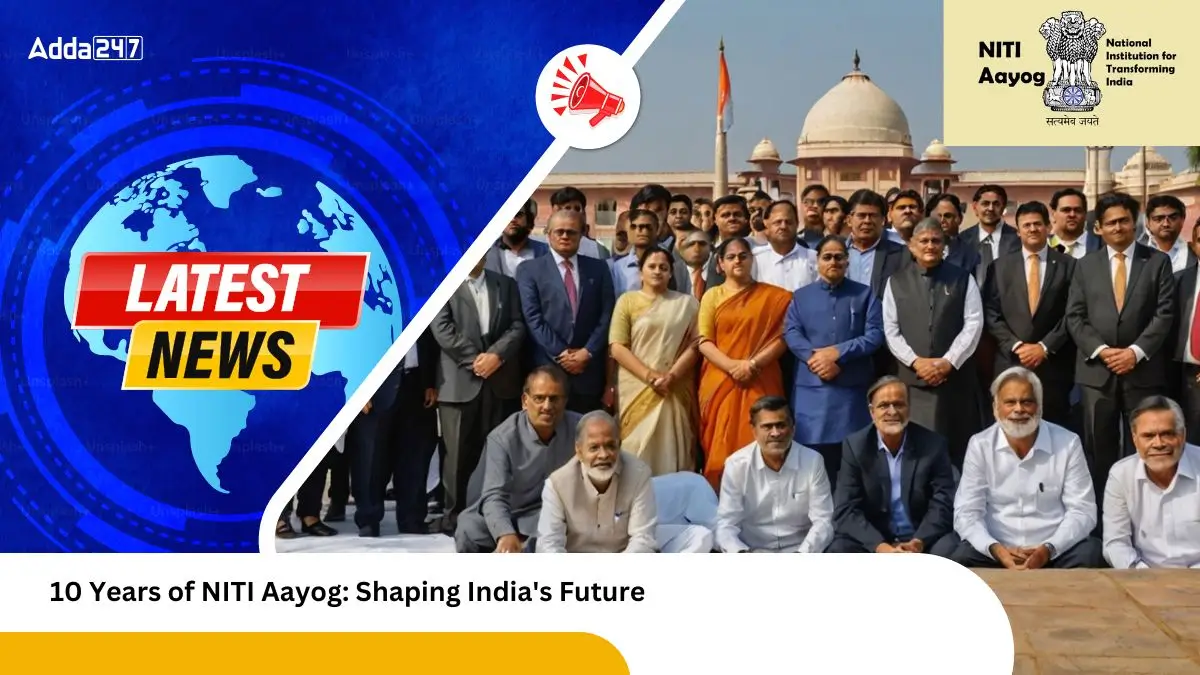NITI Aayog, established on January 1, 2015, emerged as a visionary reform in India’s governance structure, replacing the Planning Commission to better address the needs of a growing, market-driven economy. In his first Independence Day speech in 2014, Prime Minister Narendra Modi introduced NITI Aayog as an institution with a new design and structure, emphasizing a shift towards decentralization and competitive federalism. Over the past decade, NITI Aayog has evolved into a platform for policy innovation, addressing the country’s development challenges and promoting inclusive growth through collaborative governance. This article examines NITI Aayog’s evolution over the last 10 years, its key principles, major initiatives, and future challenges.
Key Insights and Achievements of NITI AAYOG’s First Decade
Decentralization and Competitive Federalism
- The establishment of NITI Aayog marked a significant shift away from the centralization of power seen in the Planning Commission.
- The focus has been on competitive and cooperative federalism, encouraging states to take initiative in their development.
- NITI Aayog introduced data-driven comparative indicators to track state progress and encourage healthy competition, such as the SDG India Index and the Composite Water Management Index.
Principle of Limited union-Level Involvement
- NITI Aayog’s role at the Union level is to promote new initiatives and provide strategic advice, but it does not directly manage financial allocations.
- Union ministries remain responsible for implementing the programs, while NITI Aayog plays a coordinating and advisory role in cross-ministry issues.
Key Initiatives and Their Impact
Aspirational District Program – 2018
- Focused on improving conditions in 112 underdeveloped districts across India in areas like health, education, agriculture, and infrastructure.
- Monthly performance tracking and rewards for high-performing districts created healthy competition and encouraged local governance reforms.
Aspirational Block Program – 2013
- Expanded to 500 underdeveloped blocks, empowering local officials and ensuring 100% coverage of key government schemes at the block level.
Atal Innovation Mission
- Launched in 2016 to promote innovation and entrepreneurship through Atal Tinkering Labs and Atal Incubation Centres.
- AIM 2.0 aims to expand innovation ecosystems, especially in tribal and hilly regions like Jammu and Kashmir and the Northeast.
Production Linked Initiative
- Aimed at boosting manufacturing and job creation, it encourages domestic production in key sectors such as electronics, textiles, and automobiles.
Partnership with States and Local Governance
- NITI Aayog works as a neutral, politically independent body, fostering a partnership with states and union territories to create a shared vision for development.
- Annual meetings with Chief Ministers and Chief Secretaries provide an opportunity for collaboration and discussion on development priorities.
- The “Team India” concept emphasizes a unified approach to address the country’s challenges and ensures that development transcends political differences.
Focus on Data Driven Decision-Making
- NITI Aayog has developed data-driven management systems to track national performance and ensure transparency in governance.
- The SDG India Index tracks states’ progress toward Sustainable Development Goals, while other indices, such as the Composite Water Management Index, have been vital in tackling pressing issues like water scarcity.
Technological Innovation for Youth Employment
- PM Modi has highlighted the importance of technology in creating employment opportunities for India’s youth. NITI Aayog’s initiatives, like AIM and PLI schemes, aim to harness technological advancements for job creation and labor productivity.
Challenges and Future Directions
- Cross-Departmental Coordination: NITI Aayog’s success hinges on its ability to work across departmental silos at the central level and with state governments to ensure coherence between short-term imperatives and long-term development goals.
- Sustainability and Climate Goals: NITI Aayog’s role in aligning India’s development agenda with global challenges, particularly climate change, will be crucial in the coming years.
- Youth Employment and Skill Development: As India’s workforce continues to grow, NITI Aayog must focus on increasing employment opportunities and skill development, leveraging technology to meet the demands of the future workforce.
Goals for 2030
- Energy Transition: Achieving 50% of energy needs from renewable sources, with 500 GW of non-fossil energy capacity and reducing carbon emissions by one billion tonnes.
- Public Health Enhancement: Strengthening public health surveillance to cover non-communicable diseases and environmental conditions.
- Sustainable Development Goals (SDGs): Aligning national policies with SDGs, focusing on poverty reduction, education, and gender equality.
Vision for 2035
- Economic Growth: Focusing on long-term economic growth while ensuring social equity and environmental sustainability, leveraging technology and innovation.
- Energy Security: Ensuring energy access, affordability, and security to meet both present and future energy demands.
- Artificial Intelligence (AI) Integration: Utilizing AI in sectors like healthcare, agriculture, education, and urban infrastructure to improve efficiency and service delivery.
About NITI AAYOG
- Established: 2015, replacing the Planning Commission.
- Aim: Focus on contemporary challenges like sustainable development, policy innovation, and governance reforms.
Composition
- Chairperson: Prime Minister of India.
- Vice-Chairperson and CEO: Lead the executive functions.
- Governing Council: Includes Chief Ministers of states and Union Territories, Lieutenant Governors of Union Territories (except Delhi and Puducherry), Vice Chairman, and full-time members.
Roles of NITI-AAYOG
- Policy Formulation & Strategic Advice: Provides advice to central and state governments.
- Promote Cooperative Federalism: Encourages collaboration between state and central governments.
- Monitoring & Evaluation: Monitors the implementation of policies and programs.
- Innovation & Research: Promotes innovation and research in key sectors.
- Promotion of SDGs: Aligns development programs with global Sustainable Development Goals.
| Summary/Static | Details |
| Why in the news? | 10 Years of NITI Aayog: Shaping India’s Future |
| Established | January 1, 2015, replacing the Planning Commission |
| Chairperson | Prime Minister of India |
| Vice-Chairperson & CEO | Leads executive functions |
| Governing Council | Chief Ministers, Lieutenant Governors, Vice Chairperson, and full-time members |
| Key Principles | Decentralization, Competitive Federalism, Data-Driven Governance |
| Major Initiatives | Aspirational District Program, Atal Innovation Mission, Production Linked Incentive Scheme |
| Aspirational District Program (2018) | Focuses on improving 112 underdeveloped districts in areas like health, education, and infrastructure |
| Aspirational Block Program (2023) | Expanded to 500 blocks to ensure 100% coverage of government schemes |
| Atal Innovation Mission (AIM) | Launched in 2016 to promote innovation through Tinkering Labs and Incubation Centres |
| Production Linked Incentive (PLI) | Encourages domestic manufacturing and job creation in key sectors like electronics and textiles |
| Partnership with States | Promotes cooperative federalism through collaboration with states and local governments |
| Key Indices Developed | SDG India Index, Composite Water Management Index |
| Technological Focus | AI integration, youth employment, and technological innovations for job creation |
| Challenges | Cross-department coordination, climate goals, youth employment, and skill development |
| Goals for 2030 | – 50% energy needs from renewable sources – 500 GW non-fossil energy capacity – Public health enhancement |
| Vision for 2035 | – Long-term economic growth – Energy security – AI integration in key sectors |
| Roles of NITI Aayog | Policy Formulation, Cooperative Federalism, Monitoring & Evaluation, Innovation & Research, SDG Promotion |



 Viksit Bharat Shiksha Adhishthan Bill, 2...
Viksit Bharat Shiksha Adhishthan Bill, 2...
 Vice-President Releases Commemorative St...
Vice-President Releases Commemorative St...
 Cabinet Nod to Atomic Energy Bill Unlock...
Cabinet Nod to Atomic Energy Bill Unlock...







